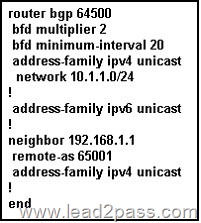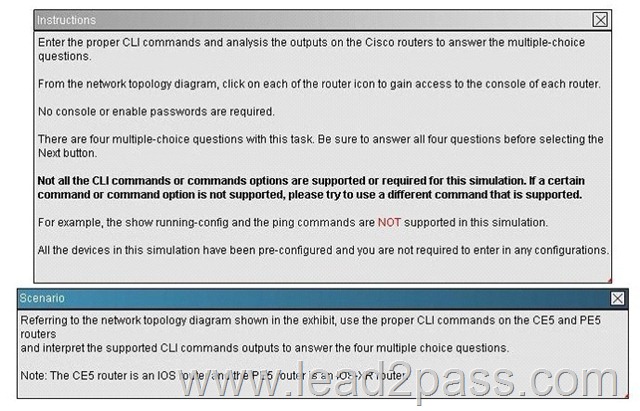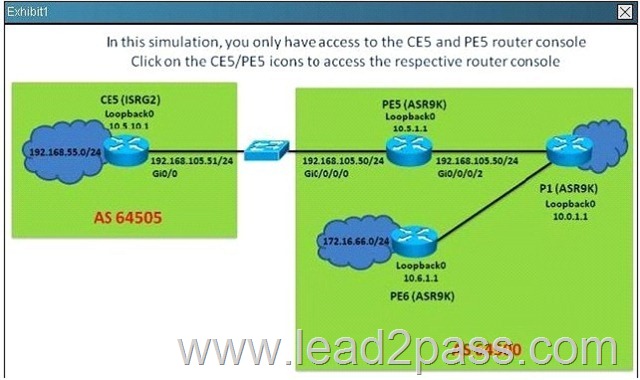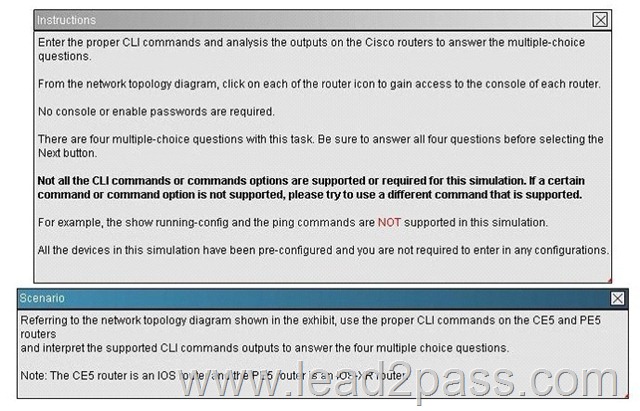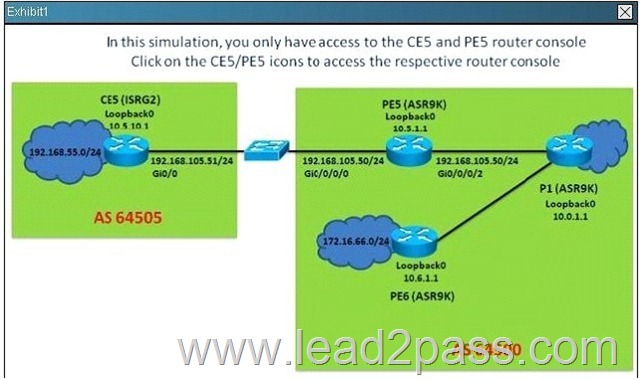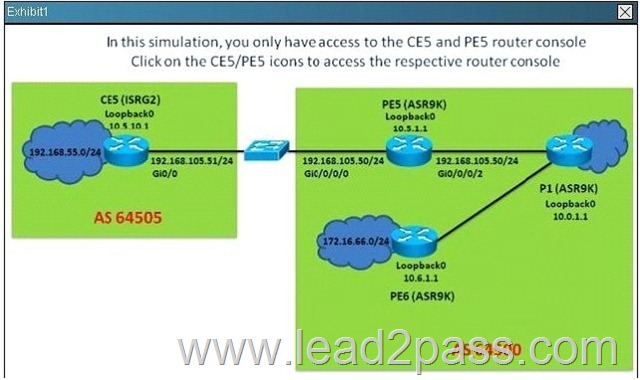2016 December Cisco Official New Released 642-885 Dumps in Lead2pass.com!
100% Free Download! 100% Pass Guaranteed!
Are you worring about the 642-885 exam? With the complete collection of 642-885 exam questions and answers, Lead2pass has assembled to take you through your 642-885 exam preparation. Each Q & A set will test your existing knowledge of 642-885 fundamentals, and offer you the latest training products that guarantee you passing 642-885 exam easily.
Following questions and answers are all new published by Cisco Official Exam Center: http://www.lead2pass.com/642-885.html
QUESTION 1
Which two attributes does BGP select before MED? (Choose two.)
A. local preference
B. weight
C. lowest router ID
D. lowest neighbor IP
E. oldest route
642-885 Exam Questions
Answer: AB
QUESTION 2
On Cisco IOS-XR, which BGP configuration group allows you to define address-family independent commands and address-family dependent commands for each address family?
A. neighbor-group
B. session-group
C. af-group
D. peer-group
Answer: A
Explanation:
Commands relating to a peer group found in Cisco IOS Release 12.2 have been removed from Cisco IOS XR software. Instead, the af-group, session-group, and neighbor-group configuration commands are added to support the neighbor in Cisco IOS XR software:
The af-group command is used to group address family-specific neighbor commands within an IPv4 or IPv6 address family. Neighbors that have the same address family configuration are able to use the address family group name for their address family- specific configuration. A neighbor inherits the configuration from an address family group by way of the use command. If a neighbor is configured to use an address family group, the neighbor will (by default) inherit the entire configuration from the address family group. However, a neighbor will not inherit all ofthe configuration from the address family group if items are explicitly configured for the neighbor.
The session-group command allows you to create a session group from which neighbors can inherit address family-independent configuration. A neighbor inherits the configuration from a session group by way of the use command. If a neighbor is configured to use a session group, the neighbor (by default) inherits the session group’s entire configuration. A neighbor does not inherit all the configuration from a session group if a configuration is done directly on that neighbor.
The neighbor-group command helps you apply the same configuration to one or more neighbors. Neighbor groups can include session groups and address family groups. This additional flexibility can create a complete configuration for a neighbor. Once a neighbor group is configured, each neighbor can inherit the configuration through the use command. If a neighbor is configured to use a neighbor group, the neighbor (by default) inherits the neighbor group’s entire BGP configuration.
However, a neighbor will not inherit all of the configuration from the neighbor group if items are explicitly configured for the neighbor. In addition, some part of the neighbor group’s configuration could be hidden if a session group or address family group was also being used
QUESTION 3
Which four operations are components of MSDP in interdomain multicast setup? (Choose four.)
A. Multiple domains can have a single statically defined RP.
B. RPs interconnect between domains with UDP connections to pass source active messages.
C. RPs interconnect between domains with TCP connections to pass source active messages.
D. RPs send source active messages for internal sources to MSDP peers.
E. Source active messages are Peer-RPF checked before accepting or forwarding.
F. RPs learn about external sources via source active messages and may trigger (S,G) joins on behalf of local receivers.
G. MSDP connections typically parallel PIM-SM connections.
Answer: CDEF
QUESTION 4
Which two specific characteristics categorize traceroute in an IPv6 routing environment? (Choose two.)
A. Traceroute can show the path to reach any destination IPv6 address.
B. Traceroute returns an error for a link-local IPv6 address.
C. Traceroute is based on ICMPv6 Type 1 (Destination Unreachable) reply packets to determine the network path.
D. Traceroute is based on ICMPv6 Type 3 (Time Exceeded) reply packets to determine the network path.
E. Traceroute is based on ICMPv6 Type 2 (Packet Too Big) reply packets to determine the network path.
F. Traceroute for IPv6 implements a backwards compatibility option to provide a detailed report in environments running dual-stack.
Answer: AD
QUESTION 5
Which multicast implementation is preferred for traffic that is required by a small number of receivers across a large distributed network?
A. DVMRP
B. PIM-DM
C. PIM-SM
D. IGMP
Answer: C
QUESTION 6
Refer to the exhibit. Which configuration is missing to complete the configuration task of enabling BFD with the 192.168.1.1 EBGP peer?
A. bfd fast-detect also needs to be enabled globally under router bgp 64500 RP/0/RSP0/CPU0:P1(config-bgp)#bfd fast-detect
B. bfd fast-detect also needs to be enabled for the address-family under address-family ipv4 unicast
RP/0/RSP0/CPU0:P1(config-bgp-af)#bfd fast-detect
C. bfd fast-detect also needs to be enabled for the 192.168.1.1 neighbor under neighbor 192.168.1.1
RP/0/RSP0/CPU0:P1(config-bgp-nbr)#bfd fast-detect
D. bfd fast-detect also needs to be enabled for the 192.168.1.1 neighbor address-family under neighbor 192.168.1.1 address-family ipv4 unicast
RP/0/RSP0/CPU0:P1(config-bgp-nbr-af)#bfd fast-detect
E. bfd fast-detect also needs to be enabled globally on the router
RP/0/RSP0/CPU0:P1(config)#bfd fast-detect
Answer: C
QUESTION 7
A service providerrequests more details about the recent Inter-AS MPLS VPN Option B configuration that was recently deployed. Consider this configuration:
router bgp 3717
address-family vpnv4 unicast
retain route-target all
commit
!
Which option describes why this particular command is needed?
A. The ASBRcan have many working customer VRFs, so this configuration ensures the coexistence of all the route-target extended communities that belong to the all ASBR-terminated customer VRFs.
B. When implementing the Inter-AS Option B MPLS VPN solution, all the route targets that are transmitted over the Inter-AS links need an ASBR local database to forward the customer traffic correctly.
C. The Inter-AS Option B design implements VPNv4 communication over the Inter-AS link, hence the requirement for a route-target association for each customer VPN connected across two or more ASs.
D. In the Inter-AS Option B design, no local VRF is maintained on the ASBR routers,so the default behavior of the operating system is to deny any route-target extended community that is encoded in the incoming iBGP updates.
This configuration permits VPNv4 communication by accepting the iBGP updates even if no route targets are configured locally.
Answer: D
Which three statements regarding the BGP operations are correct? (Choose three)
A. PE5 is the route reflector with P1 and PE6 as its client
B. PE5 is using the IS-IS route to reach the BGP next-hop for the 172.16.66.0/24 prefix
C. PE5 has BGP route dampening enabled
D. The BGP session between PE5 and P1 is established using the loopback interface and next-hop-self
E. The BGP session between PE5 and CE5 is established using the loopback interface
Answer: ACD
On the PE5 router, which statementis correct regarding the learned BGP prefixes?
A. The 209.165.201.0/27 prefix is received from the 10.0.1.1 IBGP peer which is a route reflector
B. The 172.16.66.0/24 prefix BGP next-hop points to the route reflector
C. All prefixes learned on PE5 has the default local preference value
D. The 209.165.202.128/27 prefix is originated by the 10.0.1.1 IBGP peer
Answer: C
Explanation:
#show ip bgp — check i tag for PE5
Which three statements regarding the BGP operations are correct? (Choose three)
A. PE5 will set the local preferences 200 on all the prefixes sent to CE5
B. PE5 will set the local preference to 200 on all the prefixes learned from CE5
C. CE5 has received 5 prefixes from the PE5 EBGP peer
D. CE5 has the BGP scan interval set to 30 seconds
E. CE5 is announcing the 192.168.55.0/24 prefix via EBGP to the PE5 EBGP peer
F. The AS-Path to reach the 209.165.202.128/27 prefix from CE5 is: 64500 64497 64498
Answer: CEF
Explanation:
#sh ip bgp | be Network
#sh ip bgp
#show ip bgp neighbors
QUESTION 11
What are two purposes of the BGP scan-time command? (Choose two.)
A. to tune the BGP process which walks the BGP table and confirms the reachability of next hops
B. to allow faster detection of downed BGP peers
C. to improve BGP convergence time
D. to tune the BGP update interval
E. to decrease the effects of unstable routes by increasing the route suppression time
Answer: AC
QUESTION 12
Which BGP configuration option is designed to reduce router processing load caused by unstable routes?
A. neighbor {ip-address} maximum-prefix {number}
B. bgp dampening
C. no sync
D. bgp deterministic-med
E. sync
F. bgp scan-time
Answer: B
QUESTION 13
Which three actions are prerequisites to configuring the BGP link bandwidth feature? (Choose three.)
A. enable BGP synchronization
B. configure BGP multipath first
C. configure eBGP multihop on eBGP peers
D. enable Cisco Express Forwarding on the router
E. enable BGP community propagation between link bandwidth advertising routers
Answer: BDE
QUESTION 14
Which two statements are true regarding the BGP network configuration command? (Choose two.)
A. When using the “network ip-prefix” BGP configuration command to advertise a major network into BGP,
at least one of the subnets of the major-network must be present in the BGP table.
B. When using the “network ip-prefix mask subnet-mask” BGP configuration command to advertise a classless
prefix into BGP, the prefix must have an exact match in the IP routing table.
C. When using the “network ip-prefix” BGP configuration command to advertise a major network into BGP,
at least one of the subnets of the major-network must be present in the IP routing table.
D. When using the “network ip-prefix mask subnet-mask” BGP configuration command to advertise a classless
prefix into BGP, the prefix will be announced only if there is at least one network in the specified range
in the IP routing table.
Answer: BC
QUESTION 15
External BGP peers must normally reside on a directly connected network. Sometimes it is useful to relax this restriction to enable load balancing. Which neighbor command option is used to permit this?
A. soft-reconfiguration
B. remote-as
C. ebgp-multihop
D. next-hop-self
E. send-community
F. no sync
Answer: C
QUESTION 16
Which two statements correctly describe the BGP ttl-security feature? (Choose two.)
A. This feature protects the BGP processes from CPU utilization-based attacks from EBGP neighbors which can be multiple hops away
B. This feature prevents IBGP sessions with non-directly connected IBGP neighbors
C. This feature will cause the EBGP updates from the router to be sent using a TTL of 1
D. This feature needs to be configured on each participating BGP router
E. This feature is used together with the ebgp-multihop command
Answer: AD
Explanation:
http://packetlife.net/blog/2009/nov/23/understanding-bgp-ttl-security/
QUESTION 17
When implementing source-based remote-triggered black hole filtering, which two configurations are required on the edge routers that are not the signaling router? (Choose two.)
A. A static route to a prefix that is not used in the network with a next hop set to the Null0 interface
B. A static route pointing to the IP address of the attacker
C. uRPF on all external facing interfaces at the edge routers
D. Redistribution into BGP of the static route that points to the IP address of the attacker
E. A route policy to set the redistributed static routes with the no-export BGP community
Answer: AC
Explanation:
Source-Based RTBH Filtering
With destination-based black holing, all traffic to a specific destination is dropped after the black hole has been activated, regardless of where it is coming from. Obviously, this could include legitimate traffic destined for the target. Source-based black holes provide the ability to drop traffic at the network edge based on a specific source address or range of source addresses.
If the source address (or range of addresses) of the attack can be identified (spoofed or not), it would be better to drop all traffic at the edge based on the source address, regardless of the destination address. This would permit legitimate traffic from other sources to reach the target. Implementation of source-based black hole filtering depends on Unicast Reverse Path Forwarding (uRPF), most often loose mode uRPF. Loose mode uRPF checks the packet and forwards it if there is a route entry for the source IP of the incoming packet in the router forwarding information base (FIB). If the router does not have an FIB entry for the source IP address, or if the entry points to a null interface, the Reverse Path Forwarding (RPF) check fails and the packet is dropped, as shown in Figure
2. Because uRPF validates a source IP address against its FIB entry, dropping traffic from specific source addresses is accomplished by configuring loose mode uRPF on the external interface and ensuring the RPF check fails by inserting a route to the source with a next hop of Null0.
This can be done by using a trigger device to send IBGP updates. These updates set the next hop for the source IP to an unused IP address that has a static entry at the edge, setting it to null as shown in Figure 2.
QUESTION 18
With IPv6 multicast, which feature can be used as a replacement method for static RP configuration?
A. PIM Snooping
B. MLD
C. MLD Snooping
D. Embedded RP
E. DHCPv6
Answer: D
QUESTION 19
When a BGP route reflector receives an IBGP update from a non-client IBGP peer, the route reflector will then forward the IBGP updates to which other router(s)?
A. To the other clients only
B. To the EBGP peers only
C. To the EBGP peers and other clients only
D. To the EBGP peers and other clients and non-clients
Answer: C
QUESTION 20
Which two statements regarding Auto RP operations and implementations are correct? (Choose two.)
A. Candidate RPs send RP announcements to the 224.0.1.39 multicast group, and the mapping agents send RP discovery messages to the 224.0.1.40 multicast group
B. Every PIM-SM router must be configured with the RP mapping agent IP address
C. Candidate RPs learn the IP address of the mapping agents via periodic RP discovery messages
D. Administrative scoping can be configured to limit the scope of the RP announcements
E. A Reverse Path Forwarding check is done on the RP discovery messages
F. RP discovery messages are flooded hop by hop throughout the network as multicast to the all PIM routers multicast group with a TTL of 1
Answer: AD
Explanation:
Auto-RP
Automatic route processing (Auto-RP) is a feature that automates the distribution of group-to-RP mappings in a PIM network. This feature has these benefits:
It is easy to use multiple RPs within a network to serve different group ranges.
It allows load splitting among different RPs.
It facilitates the arrangement of RPs according to the location of group participants. It avoids inconsistent, manual RP configurations that might cause connectivity problems. Multiple RPs can be used to serve different group ranges or to serve as hot backups for each other. To ensure that Auto-RP functions, configure routers as candidate RPs so that they can announce their interest in operating as an RP for certain group ranges. Additionally, a router must be designated as an RP-mapping agent that receives the RP- announcement messages from the candidate RPs, and arbitrates conflicts. The RPmapping agent sends the consistent group-to-RP mappings to all remaining routers. Thus, all routers automatically determine which RP to use for the groups they support auto- rp candidate-rp
To configure a router as a Protocol Independent Multicast (PIM) rendezvous point (RP) candidate that sends messages to the well-known CISCO-RP-ANNOUNCE multicast group (224.0.1.39), use the auto-rp candidaterp command in PIM configuration mode. To return to the default behavior, use the no form of this command. auto-rp candidate-rp type interface-path-id scope ttl-value [ group-list access-listname ] [ interval seconds ] [bidir] no auto-rp candidate-rp type interface-path-id scope ttl-value [ group-list access-listname] [ interval seconds ] [bidir]
At Lead2pass, we are positive that our Cisco 642-885 dumps with questions and answers PDF provide most in-depth solutions for individuals that are preparing for the Cisco 642-885 exam. Our updated 642-885 braindumps will allow you the opportunity to know exactly what to expect on the exam day and ensure that you can pass the exam beyond any doubt.
642-885 new questions on Google Drive: https://drive.google.com/open?id=0B3Syig5i8gpDMmVPeUw3bmhfTlU
2016 Cisco 642-885 exam dumps (All 143 Q&As) from Lead2pass:
http://www.lead2pass.com/642-885.html [100% Exam Pass Guaranteed]
